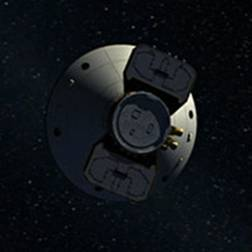15 August 2007

An Artist's Impression of the Phoenix Spacecraft
Credit: NASA/JPL
On 10 August 2007, NASA's Mars-bound Phoenix spacecraft accomplished the first and largest of six course adjustments, scheduled during the spacecraft's 9-month cruise to Mars.
Phoenix was launched on 4 August 2007, on an ambitious mission targeting to land on the Martian northern polar regions in May 2008. No space probe ever touched down on this area. Phoenix will robotically dig to underground ice and apply laboratory tests to find out whether the landing site could have ever been hospitable to microbial life.
Phoenix is currently traveling at about 33,180 m/s (approximately 120,000 km/hr) relative to the Sun. The maneuver was calculated to change the probe's velocity by about 18.5 m/s. Phoenix ignited its four mid-size thrusters for 3 minutes and 17 seconds to adjust its trajectory.
"All the subsystems are functioning as expected with few deviations from predicted performance," said Joe Guinn, Phoenix Mission System Manager at NASA's Jet Propulsion Laboratory (JPL).
The coming few weeks will feature testing science instruments, radar and the communication system that will be deployed during, and after, the landing.
The second trajectory-correction maneuver is due mid-October. "These first two together take out the bias intentionally put in at launch," said JPL's Brian Portock, Phoenix Navigation Team Chief. Without the correction maneuvers, the spacecraft would miss Mars by approximately 1 million km, a planned offset to prevent the third stage of the launch vehicle from impacting Mars. The launch vehicle is not subject to the rigorous cleanliness requirements that the spacecraft must meet to prevent Earth organisms from contaminating Mars.
Further Reading
NASA Phoenix Homepage
http://www.nasa.gov/mission_pages/phoenix/main/index.html
JPL
http://www.jpl.nasa.gov/
Aymen Mohamed Ibrahem
Senior Astronomy Specialist